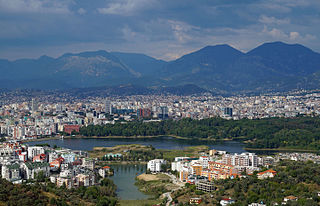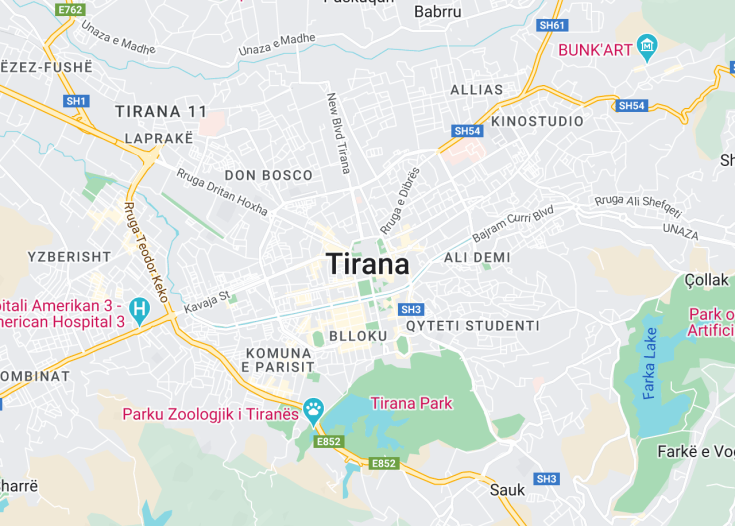Tirana, the vibrant capital of Albania, offers a unique blend of European charm and Balkan vigor. This city is an eclectic tapestry of art, history, and culture, characterized by its colorful buildings, bustling cafes, and museums. From the majestic Dajti Mountain backdrop to the verdant expanses of the Grand Park, Tirana invites visitors to explore its rich historical layers and contemporary zest. The city is particularly noted for its energetic nightlife, diverse culinary scenes, and the warm hospitality of its people, making it an appealing destination for travelers seeking an authentic and less trodden European experience.
Before exploring Tirana, visit Bunk’Art and the National History Museum to deeply understand Albania’s intriguing history and cultural evolution.
Ensure to explore Tirana’s New Bazaar, a perfect spot to indulge in local flavors and artisan products, offering a genuine taste of Albanian culture.
Top things to do & see in Tirana
Select the following sights and activities to discover best tickets and tours available in Tirana.
Tirana: The Vibrant Heart of Albania
| Country | Albania |
| Time in Tirana | GMT+1 |
| Language spoken | Albanian |
| Population | 418,495 (source: INSTAT, 2021) |
| Currency | Albanian lek (Symbol: L; Code: ALL) |
| Airports | Tirana International Airport Nënë Tereza (11 mi / 17 km). |
Tirana, the capital and largest city of Albania, serves as the cultural, economic, and governmental center of the country. Originating from Ottoman times but majorly influenced by Italian architects during the early 20th century, modern Tirana is a lively hub adorned with vibrant colors, bustling cafes, and a blend of Soviet-era and modern architecture.
The city’s rebirth can be seen in the transformation of symbolic structures such as the Skanderbeg Square, which has transitioned from a typical Soviet giant to a friendly, pedestrian-focused landscape. The recently renovated National Museum, the Pyramid of Tirana, and the Opera House stand as testaments of its rich history and cultural heritage. Nightlife in Tirana is all about lively pubs, clubs, and streets filled with the aroma of traditional cuisine.
Unique to its charm, the city offers expansive green spaces like the Grand Park. It surrounds an artificial lake offering a serene escape from the bustling city life. The Dajti Mountain, easily accessible by a cable car, offers breathtaking views of the city skyline juxtaposed against Albanian nature. Tirana’s markets, particularly the New Bazaar, are famous for their vibrant atmosphere and a variety of local produce, crafts, and antiques, making it a paradise for those wanting to experience the local life.
In the sphere of business and economics, Tirana is accelerating, attracting international investments and hosting frequent business expos and conventions, turning into a focal city in the Balkans.
Where is Tirana?
Situated in the center of Albania, Tirana lies between the Adriatic Sea and the Dinaric Alps, offering a scenic backdrop and strategic location.
Distances:
| Route | Distance by car | Time by car |
|---|---|---|
| Durrës to Tirana | 22 miles (35 km) | 34 minutes |
| Shkodër to Tirana | 59 miles (95 km) | 1 hour 32 minutes |
| Vlorë to Tirana | 77 miles (124 km) | 2 hours 30 minutes |
What is Tirana famous for?
Tirana is famous for its distinctive architecture, colorful buildings, and the bustling New Bazaar. It’s also renowned for its youthful vibrancy and the transformation of public spaces to blend tradition with modernity.
History
Prehistoric to Byzantine Era
Archaeological evidence suggests that the area around Tirana has been inhabited since the Paleolithic era. The region was home to various Illyrian tribes before falling under Roman control in the second century B.C. Following the split of the Roman Empire, the area became part of Byzantine territory. During this time, several small settlements existed in the region, primarily as passing points and trading centers between coastal towns and the interior.
15th-17th Century: Ottoman Influence
The foundation of Tirana itself dates back to 1614, when Sulejman Pasha Bargjini, a local ruler under the Ottoman Empire, established the town. A mosque, a bakery, and a hamam (Turkish bath) were some of the first constructions. The city slowly expanded but remained relatively modest in size and influence during the Ottoman period. Several landmarks from this era, including the Muradiye Mosque built in the 18th century, still stand today.
1912-1945: Formation of the Albanian State
Tirana was proclaimed the capital of Albania in 1920, a significant transition that marked its importance in national politics. The city experienced rapid growth and modernization projects initiated by King Zog in the 1920s and 30s, further establishing its status as the political and cultural hub of Albania. However, World War II brought significant destruction and changes as it was occupied first by Italy and then by Germany.
1945-1991: Communist Era
Post World War II, Albania emerged as a communist state under Enver Hoxha. Tirana became the center of the country’s political and social life, characterized by the construction of stark socialist realism architecture and urban planning, including the massive Skanderbeg Square. The period was also marked by isolation, as Albania broke ties with both the Soviet Union and China.
1991-Present: Transition and Modernity
Following the fall of communism in 1991, Tirana underwent dramatic transformations as it transitioned to a democratic system. The city experienced rapid economic development, a bustling café culture, and significant urban regeneration. Projects such as the restoration of historic buildings and the revitalization of the Lana River have been pivotal in reshaping the city’s structure and boosting its appeal as a modern European capital.
Visit Tirana
What to see and do in Tirana
Explore Tirana’s vibrant mix of history and contemporary culture. Visit Skanderbeg Square, the focal point of the city, surrounded by landmarks such as the National History Museum and the Opera House. Wander through the Blloku district, once reserved for the political elite, now a trendy area filled with boutiques, cafes, and bars. Don’t miss the Bunk’Art museum, housed in a former bunker, where you can delve into Albania’s communist past. For a touch of tranquility, visit the Dajti Mountain National Park, easily accessible by a cable car offering spectacular views of the city.
- Skanderbeg Square
- Blloku district
- Bunk’Art museum
- Dajti Mountain National Park via cable car
Festivals and Events in Tirana
Tirana is host to numerous cultural festivals and events throughout the year that highlight its rich heritage and modern European culture. The Tirana International Film Festival, held in October, showcases an array of international and Albanian films. In the spring, the Tirana Jazz Festival brings together local and international artists, while summer is marked by the colorful Tirana Street Art Festival.
Best time to visit Tirana
The best time to visit Tirana is during the spring (April to June) and early autumn (September and October). These periods offer pleasant weather, ideal for exploring the city and taking part in various outdoor activities and festivals. Summers can be quite hot, while winters are generally mild but wet.
Is Tirana worth visiting?
Indeed, Tirana is worth visiting. As a city that has seamlessly woven its rich history with a progressively modern tapestry, it offers a unique glimpse into both the past and the rapidly evolving future of the Balkans. The city’s vibrant street life, coupled with its historical monuments and the revival of its public spaces, makes it an intriguing destination for culturally curious travelers. Additionally, its café culture, burgeoning art scene, and the warmth of its residents add to its charm and appeal.









